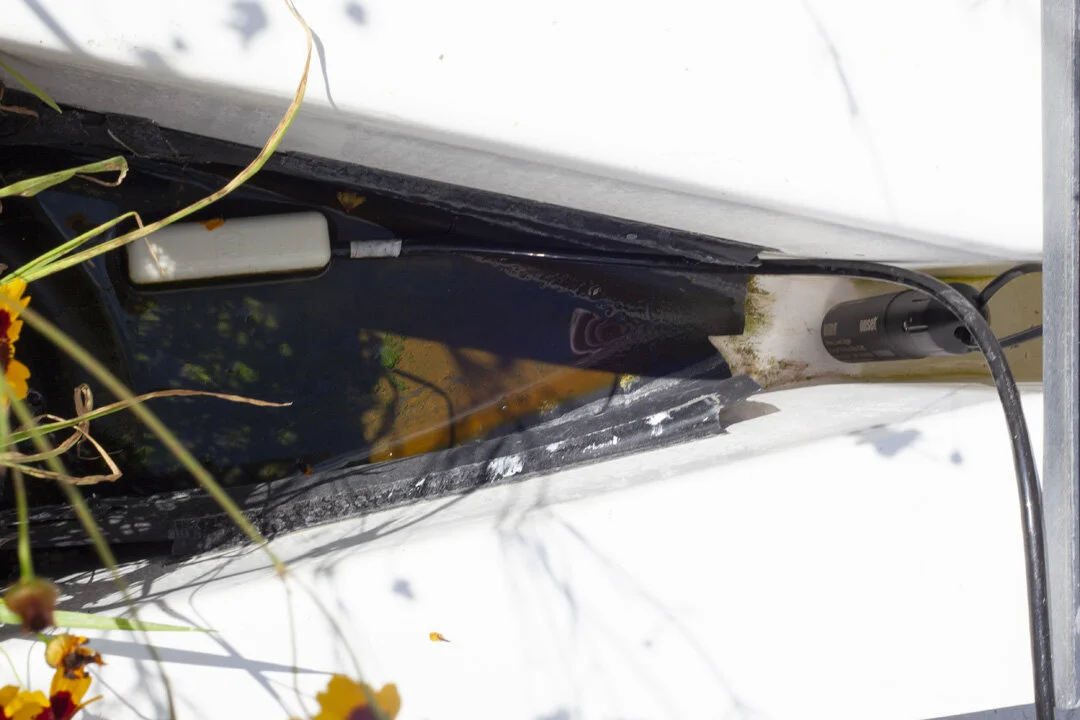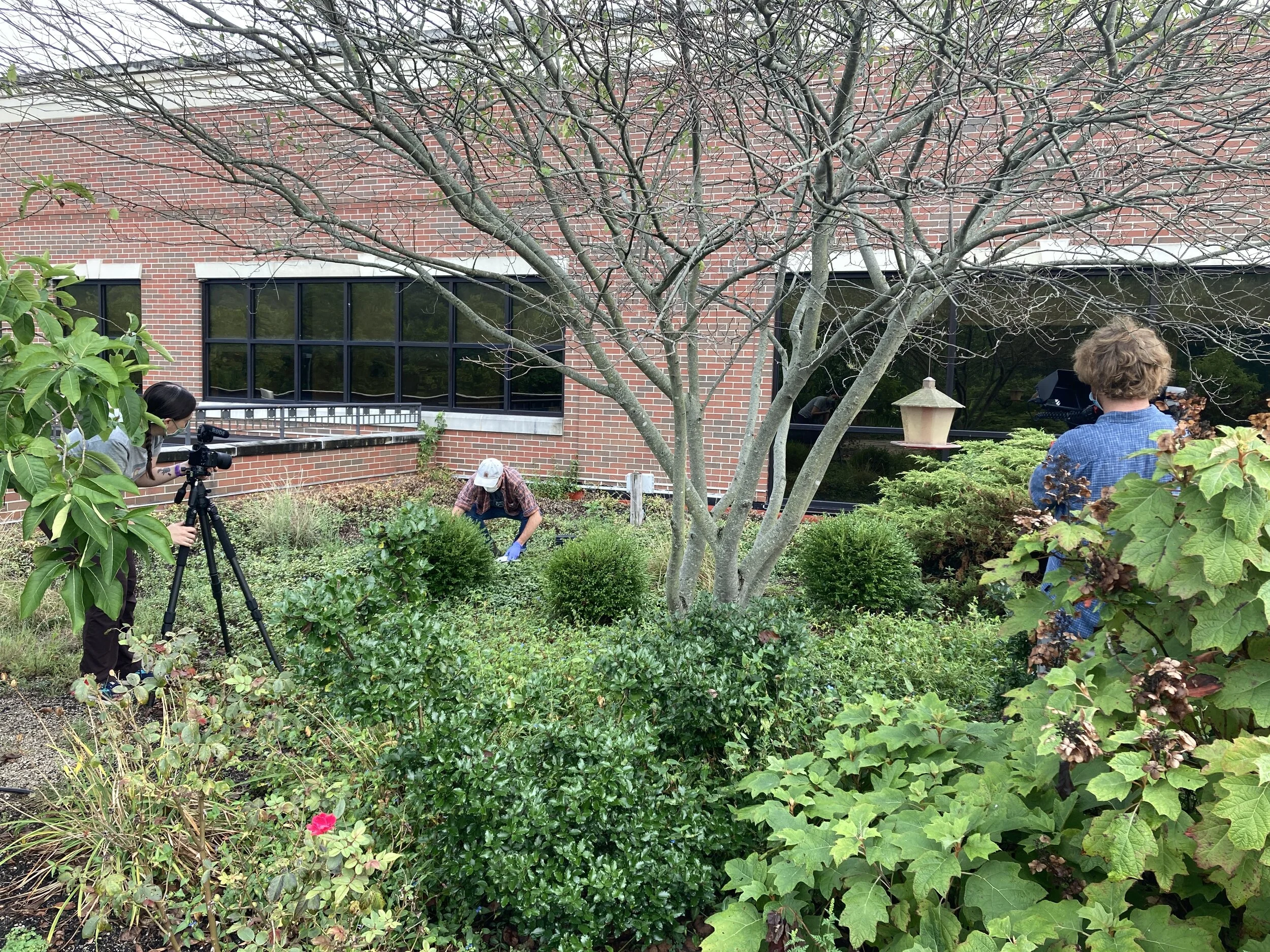Green Roof Offers Learning Opportunities at Ohio University
Advertisement
Weather station on the green roof, September 2020. (Photo: Maddy Salyer, Photojournalism student)
The Schoonover Center rooftop was covered with a white membrane that reflected sunlight into the offices and lobby of the School of Media Arts and Studies at Ohio University. Built with the intention of supporting a vegetated rooftop, the project stalled when expenses exceeded the planned building renovation budget. Five years later the Schoonover rooftop emerged as a place where faculty and students could study biological, environmental, psychosocial, and other benefits of green infrastructure. The opportunities it offered exceeded our initial expectations as a multidisciplinary group of faculty and students collaborated to bring this project to life. Two green roofs had already been installed on campus but their potential for educating students had not been explored. Both were visibly accessible to students, one just outside a student dorm over a utility tunnel and the other next to a second floor outdoor study area. Students were unaware of these systems as green roofs. This illustrated a missed opportunity to extend a system that offers significant environmental benefits to our students’ learning. A sustainability feature like a green roof can have enormous impact because it is novel, interesting, purposeful, and allows students to tap into a variety of skills.
Schoonover Center, Ohio University, Athens Ohio. July 2020 (Photo: Ben Siegel)
Imagining the new green roof project at Ohio University as an educational resource was challenged by its limited weight capacity which does not support groups of people on the roof. Its visibility was also limited except to professors and students in the School that it abuts. The first step, gaining approval to plant the roof from the Dean of Scripps College and the Director of the School, was aided by their enthusiasm for realizing the original vision. The involvement of the College of Communications had an enormous impact on our success. Students in photography, journalism, and fine arts have been essential in communicating the value of this space and of green infrastructure in general to our campus and regional communities.
Advertisement
Kyle and Joel installing the green roof model they built at a local school. (Photo: Kim Thompson)
Johnny and John test models used in outreach to illustrate benefits of green roofs. (Photo: Jack Hall, Photojournalism major)
Long before plants were selected and a design was developed, students from diverse majors joined faculty and administrators in the effort to envision the new green roof as a means for advancing sustainability literacy. Students started researching the types of plants that might improve air quality or provide pollinator habitat. Once Schoonover was confirmed as our site, students used the still unplanted rooftop as a source of material for photographic essays, a short story television piece, and inspiration for community outreach. A student group formed to promote green infrastructure on campus and beyond. Students built small models that allowed local youth attending STEM events to compare temperature and water runoff between shingled and planted surfaces. One senior mechanical engineering class undertook a year-long capstone project to design large stand-around models complete with instrumentation to support scientific discovery. Education majors wrote lesson plans to accompany the models, scheduled for donation to eight regional middle and high schools this Spring.
Our educational mission was bearing fruit well before the plants arrived. Faculty appreciated the rare opportunity afforded by a bare roof that would be planted within a year’s time and began documenting conditions on the roof. Temperature and air quality data collected before and after planting is available for student research. Organizers also recognized the advantage that limited access presented since equipment for data collection could be placed without worrying about disturbance from passersby. This opportunity was balanced by ensuring that students with research or communications proposals could gain access for their projects and that technology could support virtual interaction with the green roof. A new university subcommittee was formed to provide oversight for green infrastructure on campus, moving us from an ad hoc group to a formal entity.
Water flumes (top) allow us to collect data on water flow and quality (sensors pictured above). (Photo: Maddy Salyer, Photojournalism major)
The design of the green roof was key to making this an effective research and educational system. Vegetation was seeded in five plots, four of equivalent size, instead of encompassing the entire rooftop space. Drains on the roof that do not empty to gutters but channel the water underground presented challenges to characterizing water runoff. We worked with our local architect and Omni Ecosystems to ensure that the spacing of plots accommodated the placement of water flumes emptying into the drains. In the flumes, sensors monitor flow rate and chemistry. A weather station measures precipitation, energy exchange on bare and planted portions, water flow rate, and water quality continuously. Omni Ecosystems was recommended by a local installer, Higher Ground, because the lightweight soil supports prairie grasses and flowers on a site that was initially designed for only 20 lbs. per square foot of saturated soil.
Megan, Austin and Chad, students in Biology and MFA programs, working off campus at Holzer Clinic on a video tour and a microbiome project. (Photo: Kim Thompson)
Immediately after a July 2020 installation, students and faculty began collecting soil samples for microbial analysis and measuring arthropod abundance. This led to new partnerships on campus and beyond. Soil microbiome analysis was extended to another campus extensive green roof that had not been previously available for research and stimulated a connection with a nearby health clinic where we were permitted to collect samples on their intensive green roof. The Greater Ohio Living Architecture Center added Ohio University as a collaborator and an officer of the new student group, Laura, accepted a fellowship to complete the Green Roof Professional Training.
Students construct a bat house that will be placed on the green roof. (Photo: Steel Brooks, Masters student, Photojournalism)
To advance our commitment to making this a shared virtual, if not walkable space, students created a video tour, created social media accounts, wrote articles, developed an educational display, produced informational flyers, planned online educational outreach for schools during the pandemic, and developed a data sharing system. A streaming camera provides online access to the rooftop and time-lapse cameras capture daily changes. Many of these resources and others are available on a website through our Office of Sustainability, created by a graduate student. The Schoonover Green Roof has drawn on myriad ways to design, test, visually capture, and communicate benefits of a vegetated roof. Surveys were deployed to measure knowledge of green roofs before installation and, now that they have been validated, will help us evaluate how this new system informs our students about this valuable infrastructure as we look ahead.
Dr. Kim Thompson is an Associate Professor of Instruction in the Department of Environmental and Plant Biology at Ohio University (OHIO) in Athens. She also serves as a Sustainability Hub Coordinator at OHIO and spearheaded the interdisciplinary Green Roof Project. Kim serves on the Greater Ohio Living Architecture Center Steering Committee. She can be contacted via email at thompsk3@ohio.edu.








